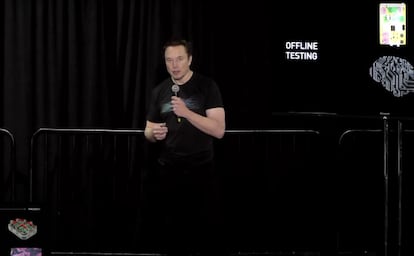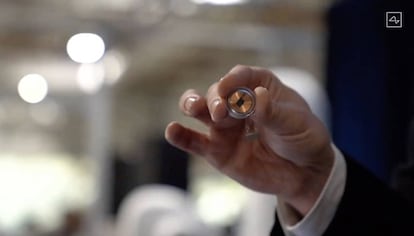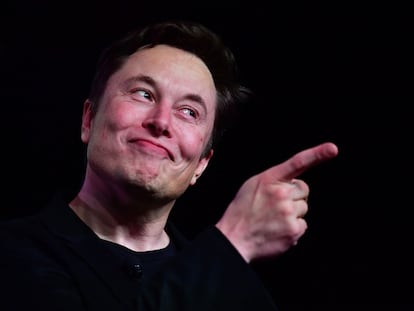Elon Musk’s Neuralink confident first chip will be implanted in a human brain in 2023
The Twitter owner said pending FDA approval a procedure to insert a semiconductor allowing the brain to connect with a computer via Bluetooth could be tested in six months


“I could have a Neuralink device implanted right now and you wouldn’t even know, hypothetically,” Twitter owner, Tesla CEO and SpaceX founder Elon Musk said during a presentation Wednesday of the latest advances from his startup Neuralink, which manufactures chips to be implanted in the human brain and which, he suggested, could be ready for testing as early as 2023. “It could be that I am one of those test samples,” he added, somewhere between joking and serious, to laughter from those present at the live-streamed event. The man who in recent weeks has infuriated the American left, staged a brief confrontation with Apple and turned Twitter on its head, for a few hours placed his role as provocateur to one side to wear the mask of a visionary entrepreneur focused on technological advances.
In 2021, Neuralink published a video of a monkey playing Pong, the Atari console video game based on the dynamics of ping pong. It became a viral sensation with more than six million views. The novelty was not that the primate, a macaque named Pager, was interacting with the game, but that he was manipulating the controls with his eyes: he was playing the game with his mind. The team at Musk’s company had implanted two chips in both sides of his head six months earlier. First, Pager was taught to play the game with a joystick, and then, according to Musk, the device was removed and the Neuralink inserted.
Now, Musk has indicated Neuralink is ready to begin human testing. “We want to be extremely careful and certain that it will work well before putting a device into a human, but we’ve submitted, I think, most of our paperwork to the FDA and we think probably in about six months we should be able to have our first Neuralink in a human,” Musk said to further applause from those present. The conference was followed online by tens of thousands of people around the world.

It was precisely on Twitter that a user asked Musk about the potential consequences of inserting the chip, which is about the size of a US 25-cent coin, into the human brain. “Once you’re in there, there’s a lot of things you can do, a lot of health monitoring,” Musk responded. “You could measure body temperature to detect a fever early... You could detect a stroke early on because you would see electrical impulses from the brain, something like a short circuit,” he added.
Musk, however, believes that the most important benefit of the Neuralink implant will be to restore vision. “I think this is notable in that even if someone has never had vision, like they were born blind, we believe we can still restore vision. The visual part of the cortex is still there. Even if they’ve never seen before, we’re confident they could see,” he said. Medical experts, however, view such claims with a pinch of salt.
Neuralink unveiled an extensive technical presentation to discuss progress made in recent months, from the evolution of the robot that inserts the chip into the brain – known as Link or R1 and developed in 2020 – to the debugging of tungsten needles, the production time of which has been drastically reduced, pointing to future mass production.
Musk’s Neuralink Corp, which has met with the approval of the Stanford Neuroscience Institute, said Wednesday that two monkeys had successfully communicated their brain activity via a computer using Bluetooth signals. Images of these macaques showed that they were using a keyboard telepathically. However, Musk stressed that they were not actually typing, but just moving a mouse cursor over the letters. The entrepreneur added that this could be a very useful application for disabled patients, enabling them to “operate their phone faster than someone who has working hands.”
In the coming months, this first primate test group will be expanded to six monkeys, with Pager receiving upgrades. Musk said the semiconductor technology, which has 1,000 channels to record stimulation information, has a very long lifespan. It was this upgrade that allowed Pager to use the keyboard. Before testing the technology on monkeys, the company conducted experiments on sheep and pigs.
One of the videos shows the brief process by which the company’s robot inserts the semiconductor: a quick pinprick lasting milliseconds. After this, however, comes the process by which the wiring is inserted to allow transmission to the external receivers. These consist of thin wires of about the thickness of a human hair. The insertion is so soft that the Neuralink team stated the procedure would not damage a grape.
Tu suscripción se está usando en otro dispositivo
¿Quieres añadir otro usuario a tu suscripción?
Si continúas leyendo en este dispositivo, no se podrá leer en el otro.
FlechaTu suscripción se está usando en otro dispositivo y solo puedes acceder a EL PAÍS desde un dispositivo a la vez.
Si quieres compartir tu cuenta, cambia tu suscripción a la modalidad Premium, así podrás añadir otro usuario. Cada uno accederá con su propia cuenta de email, lo que os permitirá personalizar vuestra experiencia en EL PAÍS.
¿Tienes una suscripción de empresa? Accede aquí para contratar más cuentas.
En el caso de no saber quién está usando tu cuenta, te recomendamos cambiar tu contraseña aquí.
Si decides continuar compartiendo tu cuenta, este mensaje se mostrará en tu dispositivo y en el de la otra persona que está usando tu cuenta de forma indefinida, afectando a tu experiencia de lectura. Puedes consultar aquí los términos y condiciones de la suscripción digital.
More information
Archived In
Últimas noticias
The murder of Michele and Rob Reiner: A tale of horrific days in Hollywood
Trump orders a ‘complete blockade of sanctioned oil tankers’ going to and from Venezuela
Not all insomnia is the same: Study identifies five subtypes and paves the way for personalized treatment
The United States designates Clan del Golfo as a foreign terrorist group
Most viewed
- ‘El Limones’ and the growing union disguise of Mexican organized crime
- Christian Louboutin: ‘Young people don’t want to be like their parents. And if their parents wear sneakers, they’re going to look for something else’
- ‘We are dying’: Cuba sinks into a health crisis amid medicine shortages and misdiagnosis
- A mountaineer, accused of manslaughter for the death of his partner during a climb: He silenced his phone and refused a helicopter rescue
- The low-cost creative revolution: How technology is making art accessible to everyone










































